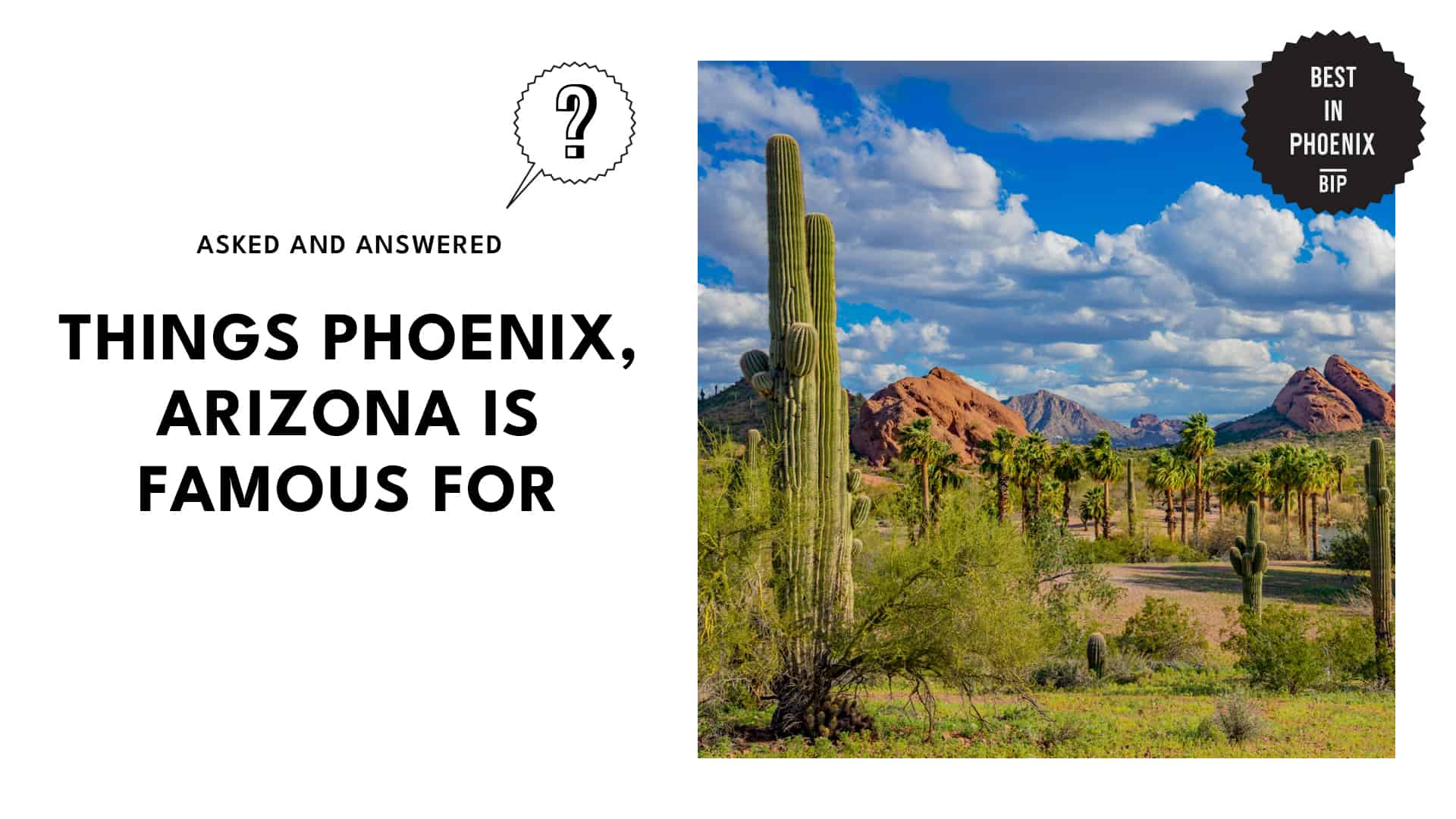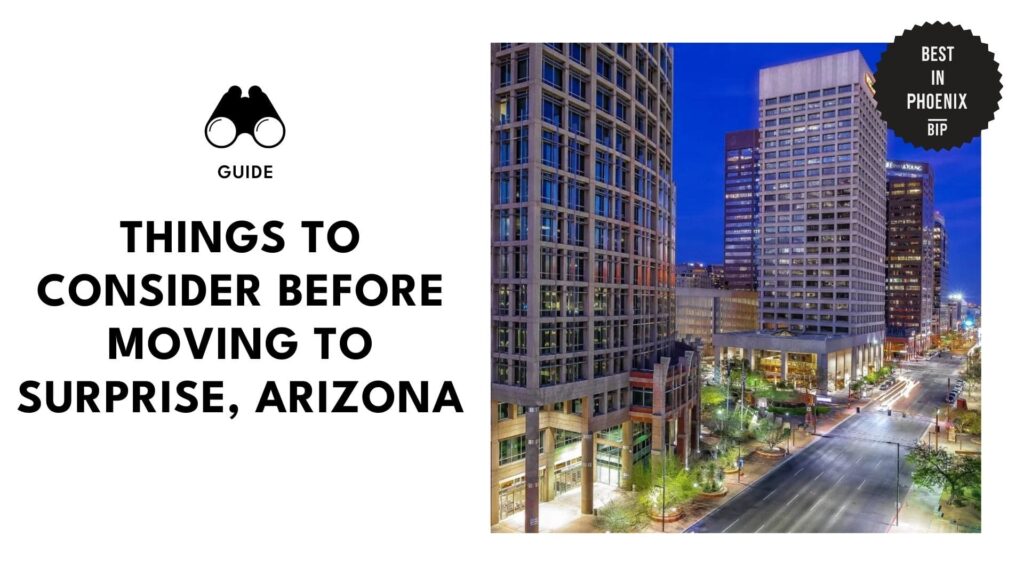Categories > Guides and Tips

44 Fun Facts You Didn’t Know About Phoenix, Arizona
- Phoenix is the fifth-largest city in the United States.
- Phoenix does not use daylight savings time.
- Phoenix is home to four deserts.
- Phoenix is home to the saguaro cacti.
- Phoenix is sunnier than any other central metropolitan area in the US.
- Phoenix has over 200 golf courses and is one of the top golf destinations in the world.
- Phoenix is famous for its unique Mexican and American cultures blend.
- Phoenix is famous for its Spanish colonial architecture.
- Phoenix boasts of Wild West history.
- Major League Baseball teams hold Spring Training in Phoenix.
- Phoenix has America’s friendliest airport.
- Phoenix is a central hub for aerospace and defense.
- Phoenix is among the best places to open a start-up company.
- Phoenix is a world-class medical hub.
- Sonoran Hotdog is an award-winning comfort food from Phoenix.
- Chimichanga is a staple food in Phoenix.
- They eat and drink prickly pear cactus in Phoenix.
- Tequila Sunrise was invented in Phoenix.
- More than 19 million people visit Phoenix each year.
- Phoenix is in the Sonoran Desert, one of the wettest and greenest deserts in the United States.
- Phoenix has all four major professional sports leagues.
- The largest Kachina doll collection in the United States is found at the Heard Museum.
- The world’s most extensive collection of desert plants can be found in Phoenix’s Desert Botanical Garden.
- The Hall of Fame has the world’s largest collection of fire-fighting equipment.
- Phoenix once had an underground bowling alley.
- The Renaissance hotel has hidden letters on the side of its building.
- Hotel San Carlos has its own Walk of Fame.
- Downtown Phoenix was in the opening scene of “Psycho.”
- Margaret Hance Park was built over the I-10 freeway tunnel.
- Downtown Phoenix has more than 50 murals.
- Hilton Garden Inn has a bank vault in the basement.
- Downtown Phoenix has more than 4,153 residential units under construction.
- Arizona Center features the state’s amphibian - the Arizona tree frog.
- The Grand Canyon inspired the architecture of the Phoenix Convention Center.
- The city is lower than the Grand Canyon.
- Most palm trees are not native to Phoenix.
- Phoenix is America’s largest state capital by population.
- Sandra Day O’Connor, the first female justice on the U.S. Supreme Court, was a resident of Phoenix.
- Phoenix Zoo is the largest non-profit zoo in the United States.
- The Musical Instrument Museum is the largest musical instrument museum in the world.
- The Phoenix Art Museum is the largest art museum in the Southwestern United States.
- A mysterious bat cave in Phoenix serves as a stopover for Mexican free-tailed bats.
- Phoenix is the largest U.S. city without Amtrak rail service.
- Anthem Veterans Memorial comes to life briefly at 11:11 am on the 11th of November each year.
More than a postcard-perfect desert escape, Phoenix is a thriving city with a vibrant history, culture, and world-class achievements. But scratch beneath the surface, and you’ll find a metropolis with unexpected secrets.
In this article, we’ll unveil hidden gems, historical quirks, and fascinating details about this city. So, buckle up and read these interesting, fun facts to discover the Phoenix you never knew existed.
1. Phoenix is the fifth-largest city in the United States.

Phoenix boasts a population of over 1.6 million residents. It’s 11.2%, making Phoenix the fastest-growing major city in the U.S. at the time.
A major factor is the Sun Belt migration trend, where people move to warmer regions with lower taxes, affordable housing, and living costs. The city has also expanded its healthcare, technology, and manufacturing sectors, attracting a young workforce.
2. Phoenix does not use daylight savings time.

Phoenix stands out for not observing daylight savings time. The state of Arizona, through a legislative action in 1968, petitioned for exemption for its use because of a lack of energy savings.
During summer, Phoenix has the same time as California, simplifying business dealings and travel. Some studies suggest Arizona’s lack of DST may lead to lower energy consumption due to reduced evening air conditioning use.
3. Phoenix is home to four deserts.

Phoenix is the only state capital in the United States to be nestled within four distinct desert regions. The Sonoran Desert is on the southern border of Phoenix and extends into Mexico.
Northwest of Phoenix is the Mojave desert, while the Chihuahuan desert is found southeast of the city. Finally, the Great Basin desert is near the Grand Canyon on the northeastern corner of Phoenix.
4. Phoenix is home to the saguaro cacti.

Phoenix, nestled in the Sonoran desert, has become one of the few native habitats for the saguaro cactus, which stands up to 50 feet tall and can live for 200 years.
It also held spiritual and practical importance for Native American tribes who used wood for tools and building materials, while the fruit, known as “honak,” was a valuable food source.
5. Phoenix is sunnier than any other central metropolitan area in the US.

Phoenix is sunnier than any other central metropolitan area in the United States, with 334 days of sunshine yearly. The hottest temperature recorded was 122°F at Sky Harbor International Airport on June 26, 1990.
A tradeoff for the warm desert weather is sandstorms called haboobs, lasting up to three hours. Unfortunately, Phoenix experiences about three haboobs a year, usually between June and September.
6. Phoenix has over 200 golf courses and is one of the top golf destinations in the world.

There are over 200 golf courses in the Greater Phoenix area. Phoenix boasts over 300 days of sunshine annually; warm winters and long spring and fall seasons extend the golfing season.
Some golf courses are championship layouts designed by legends like Jack Nicklaus and Arnold Palmer. Phoenix also hosts major PGA Tour and LPGA Tour events, including the iconic Waste Management Phoenix Open at TPC Scottsdale.
7. Phoenix is famous for its unique Mexican and American cultures blend.

Phoenix is known for its Mexican-American culture. The city has a large Mexican-American population who have contributed to its cultural scene through art, customs, and traditions.
Phoenix boasts local festivals like the annual Dia de los Muertos, which honors deceased loved ones through music, art, and traditional altars. Mexican dishes like tamales and street tacos have also become staple foods in the city.
8. Phoenix is famous for its Spanish colonial architecture.

Phoenix is famous for its Spanish Colonial history and the architecture it left in the city.
A prominent example is the Orpheum Theater, which boasts ornate Spanish Baroque details such as a large arched entrance and decorative ironwork.
The Arizona Biltmore, which played host to Marilyn Monroe and Franklin D. Roosevelt, also has Spanish colonial architecture. Visitors can also easily spot private homes and buildings that wear this architectural style.
9. Phoenix boasts of Wild West history.

Phoenix will also transport you to the Wild West era, a hotspot for cowboys and outlaws, with saloons and gambling dens. It was the location of the infamous 1881 gunfight at the O.K. Corral involving legendary gunslinger Wyatt Earp.
Cattle ranching and mining were prevalent in Phoenix, contributing significantly to the area’s growth. Today, a glimpse of what the Wild West was can be spotted in the city’s Old Town district.
10. Major League Baseball teams hold Spring Training in Phoenix.

Because of its warm climate, Arizona is always packed with supporters of Major League Baseball teams. These sports fans come to watch 15 teams practice and play in the preseason, known as Spring Training.
Phoenix has baseball complexes like Salt River Fields at Talking Stick, Scottsdale Stadium, and Camelback Ranch at Tempe Diablo. Spring Training boosts Phoenix’s economy by attracting tourism and showcasing the city to a national audience.
11. Phoenix has America’s friendliest airport.

Phoenix Sky Harbor International Airport is hailed as America’s Friendliest Airport. It serves more than 45 million passengers a year and goes to more than 120 domestic and international destinations, making it one of the busiest airports in the nation.
The airport has a “Navigator” program where volunteers in purple jackets offer assistance throughout the airport. It also showcases Arizona’s vibrant culture through art installations and live music performances for a unique and engaging ambiance.
12. Phoenix is a central hub for aerospace and defense.

Phoenix’s sunny skies, dry air, and vast open space provide ideal conditions for testing and manufacturing aircraft and aerospace components. Clear skies allow for extensive flight testing, while the dry climate minimizes corrosion and maintenance needs.
Companies like Raytheon, Honeywell International, General Dynamics, Boeing, and more than 1,200 others dominate Phoenix’s aerospace and defense industry. It’s also the home of the Luke Air Force Base, the world’s largest pilot training facility.
13. Phoenix is among the best places to open a start-up company.

Phoenix is famous for its program #yesPHX, which supports start-up companies. The city offers significantly lower business and operational costs, like cheaper land, office space, and labor, making it particularly attractive for emerging companies.
The state’s Angel Investment Tax Credit encourages investment in early-stage startups, while the Financial Services Sandbox supports testing innovative products. This environment reduces operational costs and fosters risk-taking for young companies.
14. Phoenix is a world-class medical hub.

Phoenix is a world-class medical hub home to renowned medical institutions like the Mayo Clinic, Barrow Neurological Institute, and Banner Health. Mayo Clinic Phoenix consistently ranks among the nation’s best hospitals.
The city has also invested $3.5 billion into bioscience and healthcare. Today, Phoenix ranks 5th in the United States in healthcare employment, boasting over 214,000 jobs in the city’s 850 hospitals and medical facilities.
15. Sonoran Hotdog is an award-winning comfort food from Phoenix.

The Sonoran hot dog is a popular street food in Phoenix, where roughly 5.5 million Sonoran hot dogs are devoured annually in the city. The bolillo roll is from Mexican tradition, while the hot dog and toppings are from American influences.
It’s made with a bacon-wrapped frankfurter grilled and then topped with pinto beans, onions, tomatoes, cheese, salsa, and mayonnaise, and then served on a soft roll. It’s a recipient of the James Beard Award for culinary excellence.
16. Chimichanga is a staple food in Phoenix.

The Chimichanga is a staple food in Phoenix, introduced by its vibrant Mexican-American community. It’s a deep-fried burrito filled with meat, cheese, and vegetables and served with dipping sauces, such as salsa, sour cream, or guacamole.
It got its name when, in 1946, founder Woody Johnson accidentally dropped a burrito in the fryer and exclaimed the Mexican curse word. Today, Phoenix residents consume an estimated 25 million chimichangas annually, making it a true Phoenix staple.
17. They eat and drink prickly pear cactus in Phoenix.

Phoenix is famous for incorporating the prickly pear cactus in its food and drinks. This culinary practice began when indigenous tribes and Spanish influence used it in jellies, jams, and alcoholic beverages like cactus wine.
Prickly pear offers a sweet and tart taste with a floral element and grows abundantly in the Sonoran Desert. It’s a symbol of the Sonoran Desert and its resilient ecosystem, so using it in food and drink shows the unique identity and character of the Phoenix region.
18. Tequila Sunrise was invented in Phoenix.

Phoenix is the birthplace of the Tequila Sunrise, a drink that includes tequila, crème de cassis, lime juice, and soda water. A bartender named Gene Sulit invented this drink at the Wright Bar in Phoenix.
The resulting drink has layers of orange and red, creating a vibrant sunrise effect, and tastes sweeter and fruitier than others. Mick Jagger popularized it in the ‘70s on the Rolling Stones tour and referenced it in their music.
19. More than 19 million people visit Phoenix each year.

In 2022, Phoenix welcomed a staggering 19.5 million visitors. This influx of visitors translates to an economic boom as direct spending by these tourists surpassed $4.4 billion in 2022, generating over $7.5 billion for the economy and supporting 53,000 jobs.
Phoenix continues to be an affordable getaway to witness breathtaking desert vistas, a bustling arts scene, a vibrant culinary landscape, and world-class shopping experiences.
20. Phoenix is in the Sonoran Desert, one of the wettest and greenest deserts in the United States.

Unlike most deserts with a single rainy season, the Sonoran Desert enjoys two precipitation peaks – winter storms from the Pacific Ocean from December to March and monsoonal bursts from the Gulf of California drench the land from July to September.
The iconic saguaro cactus, which can only be found in the Sonoran Desert, is a testament to the desert’s uniqueness as it can store water and survive even the smallest bursts of rain.
21. Phoenix has all four major professional sports leagues.

Unlike most states, Arizona has teams for all four major professional sports leagues – the Phoenix Suns for the NBA, Arizona Diamondbacks for the MLB, Arizona Cardinals for the NFL and Arizona Coyotes for the NHL.
Beyond the “Big Four,” Phoenix also embraces other sports like Major League Soccer’s Phoenix Rising FC and the WNBA’s Phoenix Mercury. This diverse sporting landscape solidifies Phoenix’s reputation as a true sports city.
22. The largest Kachina doll collection in the United States is found at the Heard Museum.

The Heard Museum holds the title for the most extensive Kachina doll collection in the United States, with over 1,200 of these culturally significant figures. The collection was donated in 1972 by former Arizona Senator Barry Goldwater.
Goldwater’s collection numbered around 400 dolls, which the museum expanded over the years. They feature dolls from various Hopi and Zuni pueblos or even those representing supernatural entities within Hopi and Zuni belief systems.
23. The world’s most extensive collection of desert plants can be found in Phoenix’s Desert Botanical Garden.

The Desert Botanical Garden has the world’s largest collection of desert plants, with over 50,000 plants and more than 4,500 species. The garden features cacti giants like the saguaro, desert wildflowers, and ancient cycads dating back to the dinosaur era.
They have the Hazel Hare Center for Plant Science, where scientists propagate threatened desert plants. The garden’s Herbarium also has over 93,000 plant specimens, a vital resource for studies and conservation efforts.
24. The Hall of Fame has the world’s largest collection of fire-fighting equipment.

The Hall of Fame Museum in Phoenix is home to the world’s largest collection of firefighting equipment dating back to 1725. It houses restored fire trucks, antique firefighting helmets, and other 13,000 pieces dating back to the 18th century.
The museum also has the Hall of Heroes to honor the sacrifices of the firefighters who lost their lives while doing duty since 1800. There are also interactive exhibits and immersive experiences as the Hall chronicles the evolution of this life-saving field.
25. Phoenix once had an underground bowling alley.

The Gold Spot was Phoenix’s underground bowling alley from approximately 1939 to 1950. Today, you can still see remnants of the bowling alley on the sidewalk across from the Westward Ho on the southeast corner of Central Avenue and Pierce Street.
Just look for the glass blocks on the sidewalk, once used as subterranean skylights. Local historians offer walking tours, sharing stories of a secret tunnel connecting the Gold Spot to the historic Westward Ho hotel.
26. The Renaissance hotel has hidden letters on the side of its building.

The faded remnants of the old signage became visible again during a 2001 renovation of the Renaissance hotel. The “ghost letters” are created with reflective material hidden during the day.
Head to First and Adams Streets and find the Renaissance Phoenix Downtown Hotel to find the letters at night. Stand across the street from the valet area on First Street and point your camera toward the East-facing wall until you capture the “PHX” letters.
27. Hotel San Carlos has its own Walk of Fame.

Hotel San Carlos has a Walk of Fame on its sidewalks commemorating the legendary actors and actresses who once graced the hotel. It was installed in 1993 to celebrate the hotel’s 65th anniversary.
The San Carlos Walk of Fame boasts over a dozen stars, such as Jean Harlow, Clark Gable, Marilyn Monroe and Mae West. In 2019, the hotel held a public vote to add a 13th star, where John Wayne emerged as the winner.
28. Downtown Phoenix was in the opening scene of “Psycho.”

In the opening scene of Alfred Hitchcock’s iconic 1960 thriller, “Psycho,” the sun-drenched skyline of downtown Phoenix takes center stage, and the camera pans across the mid-century cityscape.
The scene showcased landmarks like the Security Building, Hotel San Carlos, and the Luhrs Building. Today, Phoenix embraces its “Psycho” connection with annual “Psycho Day” celebrations and walking tours highlighting the film’s locations.
29. Margaret Hance Park was built over the I-10 freeway tunnel.

The Margaret Hance Park was built atop the 2,800-foot-long Interstate-10 and deck park tunnels. Today, the park hosts food festivals, community events and the NCAA Final Four March Madness Music Festival with 20,000 attendees.
This engineering feat was completed in 1990, allowing I-10 to navigate a congested downtown Phoenix area without sacrificing valuable green space. The tunnel also holds a hidden layer for an express bus station but wasn’t completed due to lack of funding.
30. Downtown Phoenix has more than 50 murals.

Downtown Phoenix is an artistic hub thanks to initiatives like the PHX Mural Project and Roosevelt Row’s “Mural Alley.” These projects support local artists and have produced over 50 murals on sustainability and indigenous themes.
Downtown Phoenix is also known for its First Friday Art Walk, where thousands flock to visit galleries, performances and murals. Murals like “We Rise Together” by Lalo Cota and “Desert Bloom” by Ashley Macias have become beloved landmarks.
31. Hilton Garden Inn has a bank vault in the basement.

Before it was the Hilton Garden Inn, the building was the home of the Valley National Bank of Arizona from 1932 to 1972. In 2016, it was renovated to become a 170-room hotel, but they kept the 4-foot-thick concrete vault.
The hotel has even incorporated the vault into its design and used it as storage. The building, a 13-story Art Deco masterpiece, was even featured in the opening scene of Alfred Hitchcock’s classic thriller “Psycho.”
32. Downtown Phoenix has more than 4,153 residential units under construction.

Downtown Phoenix’s population is expected to nearly double in the next five years, fueled by a surge in residential construction. Over 4,153 units are currently under development, adding condos and apartments to the urban core.
Projects contributing to the residential boom include the AVE Phoenix Sky, with 250 luxury units; the 747 Project, with 747 residential units and 29,000 square feet of commercial space; and the Eastlake Park, offering 200 multifamily units.
33. Arizona Center features the state’s amphibian – the Arizona tree frog.

The Arizona Center is where you can find Arizona’s official state amphibian – the Arizona tree frog. It has emerald green skin and sticky toes in the center’s lush grotto, which features a cascading waterfall, a koi pond, and greenery.
The Arizona tree frog is listed as a “Species of Special Concern.” So, the center conducts educational programs that raise awareness about the Arizona tree frog, its role in the ecosystem, and the threats it faces.
34. The Grand Canyon inspired the architecture of the Phoenix Convention Center.

The Grand Canyon inspired the architecture of the Phoenix Convention Center when it was expanded in 2008. Architects channeled the Canyon’s essence through the rust-colored exterior mirrors of the canyon’s layered sandstone cliffs.
On the other hand, the turquoise glass accents echo the vibrant hues of the Colorado River. The building’s layout evokes the canyon’s grandeur, with atriums, open spaces and the use of native plants and artwork reflecting Arizona’s topography.
35. The city is lower than the Grand Canyon.

Phoenix has an average elevation of 1,086 feet, substantially lower than the Grand Canyon’s lowest point at 2,400 feet. As a result, desert plants like saguaro cactus thrive in Phoenix, while ponderosa pines appear in higher reaches of the canyon.
This elevation difference also creates a climatic contrast as Phoenix basks in sunshine and desert heat while the canyon rim enjoys cooler temperatures and even the occasional dusting of snow.
36. Most palm trees are not native to Phoenix.

Although several palm trees are seen throughout Phoenix today, only one – the California fan palm – is native to the city. This plant thrives in the Kofa National Wildlife Refuge.
The rest of the palm trees come from Mexico, Australia, and the Caribbean, brought by early 20th-century developers who sought to transform Phoenix into a desert oasis. Today, over 200,000 non-native palms line streets and grace resort pools.
37. Phoenix is America’s largest state capital by population.

With 4.7 million people, Phoenix is America’s largest state capital by population. This influx of residents has transformed Phoenix into a dynamic and diverse hub.
The city’s booming economy, fueled by the healthcare, technology, and tourism sectors, entices job seekers and entrepreneurs. Phoenix also has a relatively affordable housing market, which makes it an attractive destination for young families and retirees.
38. Sandra Day O’Connor, the first female justice on the U.S. Supreme Court, was a resident of Phoenix.

Sandra Day O’Connor arrived in Phoenix with her family in 1957 and became one of the first female attorneys in Phoenix and later the first female justice in American history.
Throughout her 24-year tenure on the Court, O’Connor maintained a close connection to Phoenix. She frequently returned to the city, participating in local events and remained active in Arizona politics.
39. Phoenix Zoo is the largest non-profit zoo in the United States.

Phoenix Zoo is the largest non-profit zoo in the United States, sprawling 125 acres and housing over 3,000 animals and nearly 400 species, many of which are threatened or endangered.
You’ll see African lions, black bears, giraffes and meerkats here. It’s also a hub for conservation and education, with a passionate team dedicated to protecting endangered species and inspiring appreciation for the natural world.
40. The Musical Instrument Museum is the largest musical instrument museum in the world.

The Musical Instrument Museum boasts a staggering collection of over 16,000 instruments from nearly 200 countries. No wonder it holds the title of the largest musical instrument museum in the world.
This collection spans continents from ancient Egyptian sistrums to intricate Chinese guqin, from Peruvian panpipes to Brazilian surdos. Recent additions include a rare 17th-century harpsichord from France and a collection of traditional Korean instruments.
41. The Phoenix Art Museum is the largest art museum in the Southwestern United States.

The Phoenix Art Museum is the largest art museum in the Southwestern United States, with over 20,000 artworks. Its vast halls house treasures like Diego Rivera’s murals, Georgia O’Keeffe’s landscapes, and a trove of Asian ceramics.
The museum added recently the “Dior: Celebrating Haute Couture” and “William Herbert ‘Buck’ Dunton: A Mainer Goes West.” They also conduct free “First Fridays,” where the community can explore art after dark to support Phoenix’s cultural scene.
42. A mysterious bat cave in Phoenix serves as a stopover for Mexican free-tailed bats.

Nestled within the rugged McDowell Mountains, the Phoenix Bat Cave is a vital haven for a colony of over 8 million Mexican free-tailed bats. It’s an ecological keystone, playing a crucial role in maintaining the delicate balance of the desert ecosystem.
This usually happens when 10,000 to 20,000 bats are on their way to Mexico between May and October every year. Studies show that some of these bats travel as far as Montana and Canada for the summer and return to the Phoenix Bat Cave each fall.
43. Phoenix is the largest U.S. city without Amtrak rail service.

Phoenix is the biggest U.S. city without an Amtrak station in sight. Until 1996, Amtrak’s Sunset Limited proudly called Union Station its Phoenix home, but a tragic derailment and death of an employee led Amtrak to stop its service to Phoenix in June 1996.
While Amtrak remains absent, Phoenix has commuter rail lines connecting surrounding suburbs, and Greyhound buses offer intercity connections. Arizona and Phoenix have prioritized car-based transportation infrastructure such as highways ever since.
44. Anthem Veterans Memorial comes to life briefly at 11:11 am on the 11th of November each year.

Every year, on the 11th hour of the 11th day of the 11th month, at 11:11 AM, the Anthem Veterans Memorial comes alive as a tribute to the sacrifices of American veterans. The five white pillars, representing military branches, are positioned at specific angles.
As the sun peaks on Veterans Day, its rays pierce through elliptical cutouts in the pillars, creating a mosaic of the Great Seal of the United States. This solar alignment, achieved through complex astronomical calculations, lasts seconds.





